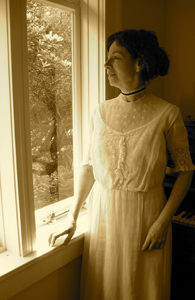![[Metroactive Stage]](/stage/gifs/stage468.gif)
[ Stage Index | Silicon Valley | Metroactive Home | Archives ]

I Write, Therefore I Amherst: Diane Tasca channels Emily Dickinson. For Whom the Belle Tolls Emily Dickinson surfaces on a current of charisma in Pear production By Marianne Messina A FIRST-TIME READER of Emily Dickinson may hear her short, simple iambic lines, crowned with the so-called "forced rhyme," and place them somewhere between limerick and Hallmark greeting. Likewise, the 19th-century scholar Thomas Wentworth Higginson, who first rejected her poems (as well as Walt Whitman's), may have been fooled by Dickinson's subtle verse. To access Dickinson, one must sit with the poems quietly, then approach not only with openness and curiosity, but with breath and depth of experience. The Pear Theatre's Diane Tasca plays Dickinson with that kind of subtlety, breadth and depth in The Belle of Amherst. William Luce's script is rife with Dickinson's poetry, which Tasca merges so smoothly into the monologue that if you don't recognize those titular first lines, the poetic composition takes you by surprise. And Tasca's performance reveals the poems as the natural musical echo of the human instrument who created them. As a one-woman show, this Pear Theatre production is at once a terribly gentle and incredibly grueling two hours of theater. Gentle, in that Tasca's Dickinson is full of childlike glee and awe for both the beauty and the sinister undertones of nature. Tasca becomes the person who keeps the Sabbath by "staying at home with a bobolink for a chorister" and who sees Autumn in amherst (Mass.) as "The moon rides like a girl through a topaz town." She comes out in the white dress that she will wear for the entire show. The dress, like all else, looks plain and simple at first but is intricately patterned on deeper inspection. With a kind of inner fire, she embraces the detail of what might on the surface seem mundane or irrelevant—a recipe for black cake for instance. The play is grueling in that Dickinson's beauty and curiosity are often met with longing and loss, so that in Act 2, as Dickinson's world of friends, family and hope (for publication) crumbles under the great losses of life, Tasca's all-too-believable tears are excruciating. Also striking is the production's relaxed, hearthside pacing. Eras have their own rhythms, and Dickinson's era had a rhythm in which a black cake to serve your guests was the result of three to eight hours of baking. And getting a new dress was a lengthy home project sewn from a pattern ordered by mail. Tasca allows easy silences and slow topical shifts to sit cozily around her, which is part of the play's challenge and its charm. In the place of terminal busyness Tasca relies on a low-voltage current of charisma—even a stare out the window remains alive and prickly, as she converts the Pear's tiny space, audience and all, into her homestead parlor. The play can be very funny; in fact, until probably the last quarter, it maintains an even balance between pathos and humor. With the free-spiritedness of the boy that Dickinson's poems often claimed their author to have been in youth, she tells of terrorizing her sister with snakes and taunting a teacher who would bowdlerize Shakespeare by reciting a succession of the bard's most racy moments. These days, there is no shortage of plays in which middle-aged women onion-peel their memories, delving for meaning in the paths of their lives, but this charged examination is by far one of the most substantial you're going to see.
The Belle of Amherst plays Thursday-Saturday at 8pm and Sunday at 2pm through May 8 at the Pear Avenue Theatre, 1220 Pear Ave., Mountain View. Tickets are $10-$15. (650.254.1148)
Send a letter to the editor about this story to letters@metronews.com. [ Silicon Valley | Metroactive Home | Archives ]
|
From the April 20-26, 2005 issue of Metro, Silicon Valley's Weekly Newspaper.
Copyright © Metro Publishing Inc. Metroactive is affiliated with the Boulevards Network.
For more information about the San Jose/Silicon Valley area, visit sanjose.com.